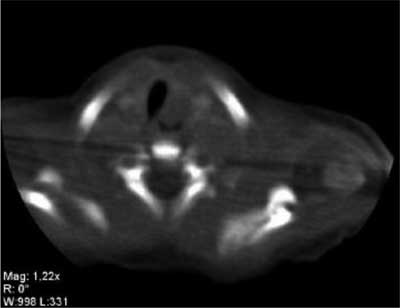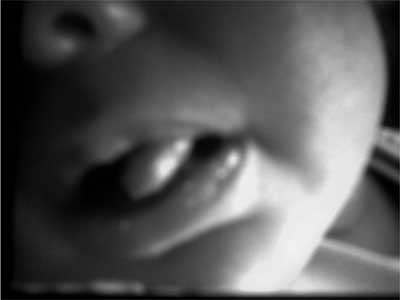© Borgis - New Medicine 4/2010, s. 130-132
*Małgorzata Dębska, Mieczysław Chmielik
Pharyngeal tumours in infants
Department of Paediatric Otorhinolaryngology, Medical University of Warsaw, Poland
Head of Department: prof. Mieczysław Chmielik, MD, PhD
Summary
The paper discusses 4 cases of pharyngeal tumours in 2 neonates, an infant and a 7-year-old child. The tumours were initially asymptomatic. They were detected in the children?s mouths by their parents or by doctors. The authors describe the diagnosis, the course and the treatment of these patients. It is important to note the young age of the patients and the initially asymptomatic course, despite the considerable size of the tumours.
INTRODUCTION
Pharyngeal tumours in neonates, infants and small children are very rare. In the period 2002-2009, 4 children with this diagnosis were hospitalised in the Children?s Otolaryngology Clinic of the Medical University of Warsaw. The literature quotes cases of teratoma of the pharynx, or ? more rarely ? dermoid cysts, cysts, angioma or fibroma as more frequent lesions in these patients. Malignant tumours that occur are rhabdomyosarcoma, lymphoma, or leukaemic infiltration. Pharyngeal tumours cause swallowing problems and respiratory failure, but can initially be asymptomatic.
The diagnostic process consists of: history, paediatric and laryngological physical examination, laboratory tests (alpha-fetoprotein, LDH, ferritin, basic examination), and imaging examinations ? ultrasound, CT, and throat and neck MRI. Chest X-ray and ultrasound of the abdominal cavity are performed in order to rule out tumourous lesions in other organs. Pharyngeal tumours are treated surgically. The resection is either curative or performed to obtain a sample for histological examination (in the case of maiming surgery). In the case of some malignant lesions, in order to reduce the tumour burden and the scope of the surgical intervention, chemotherapy is administered before the surgical intervention.
OBJECTIVES OF THE STUDY
Evaluation of the symptoms, the course, the diagnostics and the outcomes of the treatment of pharyngeal tumours in children.
METHODS
Four cases of pharyngeal tumours in children were analysed on the basis of their medical documentation.
DISCUSSION
Three of the patients who were admitted to the Children?s Laryngology Clinic were neonates or infants
? aged from 13 days to 6 weeks. One of them was
7 years old. The latter child was included in the present article due to the history. In early childhood, the child presented with nasal patency disorders, snoring and closed rhinolalia. But it remained undiagnosed at the time, treated as a case of hypertrophy of the third tonsil which should subside with time. The symptoms did seem to resolve, probably due to lowering of the lesion in the nasopharynx towards the mesopharynx. During the next 6 years, the child did not present with any symptoms of the pharyngeal tumour, which had probably been present since birth, but remained undiagnosed.
In all the cases the course was initially asymptomatic or the symptoms were mild and unspecific: sporadic vomiting, spitting up, fatigue during breastfeeding, hoarse breathing. In 3 cases the lesions, which had been undetected during laryngological throat and oral cavity examination, were discovered by the child?s parents. After admission, 2 patients suffered from sudden dyspnoea and required immediate intubation. This is the reason why in 1 case no imaging examinations were performed ? the child underwent an emergency endoscopy of the respiratory tract, in the course of which the pharyngeal tumour was detected and removed.
In the remaining 3 cases ultrasound and throat and neck CT imaging examinations were performed, and they confirmed the diagnosis (fig. 1). In 2 cases, the radiological examination confirmed the presence of a tumourous lesion in the oesophagus, accounting for the earlier vomiting and the symptoms of swallowing disorders.
In 3 cases the lesion stemmed from the palatal arches, in 1 case from the nasopharynx. The tumours stemming from the palatal arches had long stalks. In the histological examination teratoma was confirmed in 3 cases and angiofibroma in 1 case.
Respiratory disorders in patients with pharyngeal tumours are due to airway narrowing or compression caused by the lesion occluding the lumen of the pharynx, or to laryngeal nerve paralysis. Also the swallowing difficulties are caused by the lesion occluding the lumen of the pharynx (2 cases in our material), compressing or narrowing it. Initially, the patients did not present with dyspnoea or swallowing problems, despite the large size of the tumours (the smallest of them was approximately 2 cm in diameter). Fortunately, they suffered dyspnoea incidents, precipitated by the laryngeal examination, only after admission. It can be posited that the tumour was dislocated from the oesophagus to the larynx or the laryngopharynx.
It should be noted that a normal laryngological examination does not mean that a doctor can forgo a detailed diagnostic process in cases where the parents report abnormal structures in their child?s mouth (fig. 2). This was the case in 3 children. Sometimes the tumours were only visible after spitting up, and then they disappeared.
All the tumours were surgically removed without complications.
| Initials No. of history | Age | In what circumstances the tumour was found | Symptoms prior to hospitalisation | Clinical course | Additional examinations | Site of thelesion | Size (mm) | Histological exam |
| PJ//3492//03 | 18 days | Lesion in the oral cavity noticed by the parents | Sporadic vomiting, hoarse breathing | At admission, no symptoms of swallowing problems or dyspnoea. During hospitalisation, sudden dyspnoea requiring intubation | Basic examination, US and throat CT, oesophagus contrast x-ray | Left palatopharyngeal arch | 19x12x9 | teratoma |
| WL//11661//04 | 6 weeks | Lesion found in the Oncology Clinic of the Children's Memorial Health Institute | Intermittent swallowing problems, fatigue during breastfeeding | At admission, no symptoms of swallowing problems or dyspnoea. During laryngological examination, sudden dyspnoea requiring intubation | Basic examinations | Left palatopharyngeal arch | 20 in diameter | teratoma |
| BW//5568//09 | 13 days | Lesion in the oral cavity noticed by the parents | Asymptomatic | At admission, no symptoms of swallowing problems or dyspnoea. | Basic examination, US and throat CT, contrast x-ray of the oesophagus | Left palatoglossal arch | 23x13 | angiofibroma |
| OS//10489//05 | 7 years | Bleeding in the oral cavity during vomiting in the course of an infection noticed by the parents | Asymptomatic. In early childhood, symptoms included: nasal patency disorders, snoring, rhinolalia - undiagnosed | At admission, sensation of foreign body in the oral cavity, problems with swallowing saliva; no dyspnoea | Basic examination, US and throat CT, contrast x-ray of the oesophagus | Medially on the posterior wall of the pharynx, from the adenoid to the base of the tongue | 41x18x30 | teratoma |

Fig. 1. Neck CT.

Fig. 2. Abnormal structures in mouth.
CONCLUSIONS
1. Pharyngeal tumours in infants are very rare.
2. Pharyngeal tumours in infants can be initially mildly symptomatic and are often diagnosed accidentally.
3. Initially, they can cause respiratory and swallowing difficulties.
4. Teratoma is the most frequent type.
5. Treatment is surgical.
Piśmiennictwo
1. Brożek J (ed.): Postępy w leczeniu i rozpoznawaniu nowotworów u dzieci. PZWL 1981. 2. Chmielik M (ed.): Otolaryngologia dziecięca. PZWL 2001. 3. Gryczyńska D (ed.): Otolaryngologia dziecięca. a-Medica-Press 2007. 4. Pathology of the Head and Neck. Cardesa A., Slootweg PJ. Springer-Verlag Berlin-Heildelberg 2006. 5. Bielicka A et al.: Teratomas of the nasopharynx in children. A report of three cases. New Medicine 3/2006.

